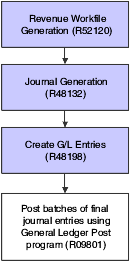13 Understanding Revenue Recognition for PGCA Contracts
This chapter contains the following topics:
13.1 Revenue Recognition for PGCA Contracts
To recognize revenue for government contracts, you use the same programs within JD Edwards EnterpriseOne Contract and Service Billing that you use for regular contracts (document type R2). However, because PGCA contracts include unique contract terms, such as period of performance (POP) dates, revenue limit amounts, and additional methods for calculating fees, the revenue recognition programs perform additional tasks when you run them for PGCA contracts.
This flowchart illustrates the revenue recognition process for PGCA contracts:
Figure 13-1 Revenue recognition process for PGCA contracts

Description of "Figure 13-1 Revenue recognition process for PGCA contracts"
The highlighted programs in the preceding flowchart represent the steps in the revenue recognition process where the system performs additional actions for PGCA contracts. These programs are described in the following topics.
13.1.1 Revenue Workfile Generation Program
After you run the Workfile Generation program (R48120), you run the Revenue Workfile Generation program (R52120). This program creates records in the Billing Detail Workfile table (F4812) for non-time and materials (T & M) billing lines, such as lump sum and unit price. Unit price and lump sum billing lines are not associated with transactions, therefore, without running the R52120 program, the F4812 table does not contain the information needed by the R48132 program to calculate revenue amounts.
When you run the R52120 program for PGCA contracts, the R52120 performs the additional task of creating placeholder records in the F4812 table for two of the fee calculation methods that are used only with PGCA contracts. The two methods are the flat amount method and the percent of limit value method. To calculate fees using these two methods, the R48132 uses information from the Contract Master table (F5201) and the Contract Billing Line Detail table (F5202) instead of transaction amounts within the F4812 table. The R48132 program uses the placeholder records that are created by the R52120 program to retrieve the information from the F5201 and F5202 tables.
See Understanding Fee and Award Fee Billing Lines for PGCA Contracts.
|
Note: The R52120 also creates placeholder records for the two revenue-only billing lines (line types G and H). Although these billing line types can be used for non-PGCA contracts, they are used frequently in government contracts. |
13.1.2 Journal Generation Program
You run the Journal Generation program (R48132) to create preliminary journal entries for revenue. Creating preliminary journal entries enables you to review the journal entries before posting them to the Account Ledger table (F0911). You can review the preliminary entries and correct errors within the batch before creating final journal entries. These are the additional tasks that the system performs when you run the R48132 for PGCA contracts:
-
Compares the value in the Revenue Status to Include field in the F5201 table for each PGCA contract to the value in the corresponding processing option for the R48132 program to determine whether the contract should be included in revenue processing.
-
Loops through the records in the F5280W table to accumulate the amounts for each contract and pricing type group and then determines whether the amounts exceed revenue limits for any contracts
-
Creates records in the F4812 table with a billing line type of X, for contracts for which revenue limits have been exceeded.
For these records, the system also updates the Transaction Classification field (TCLS) with the value that corresponds to the type of amount that was exceeded. Values include:
-
I: Cost limit excess
-
J: Fee limit excess
-
K: Award fee limit excess
-
L: Total limit excess
-
-
Loops through the new records with a billing line type of X to include them in the revenue batch.
The system performs this action if at least one record with a billing line type of X exists.
-
Reviews the Enforce Period of Performance check box for each contract to determine whether to enforce POP dates.
For contracts where POP dates are enforced, the system does not include revenue entries that contain dates that are outside of the POP date range.
13.1.3 Create G/L Entries Program
You run the Create G/L Entries program (R48198) to create the final journal entries in the F0911 table. These are the additional tasks that the system performs when you run the R48198 program for PGCA contracts:
-
Loops through the F5280W table to accumulate revenue and revenue excess amounts by contract.
-
Inserts the revenue and revenue excess amounts into the F52G200 table.